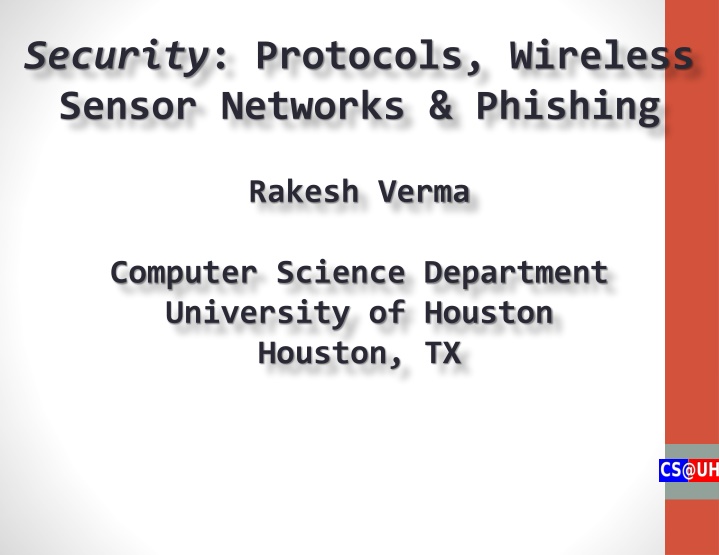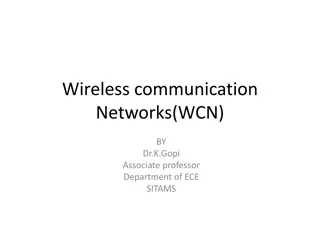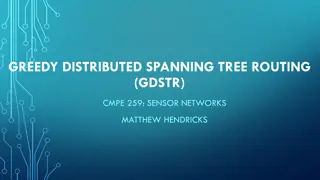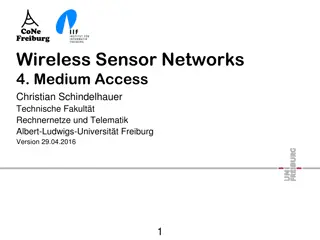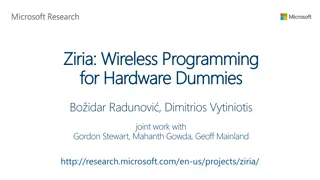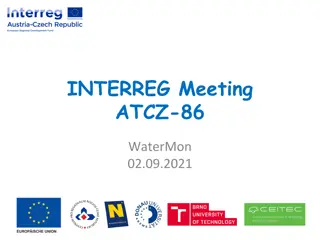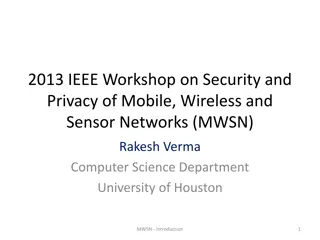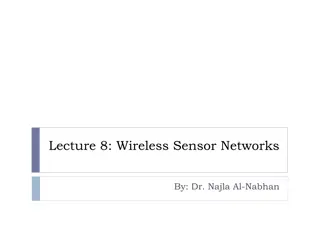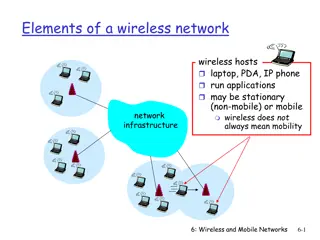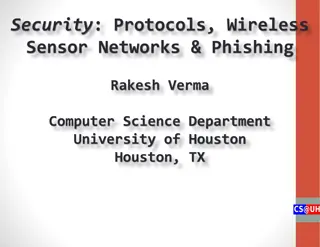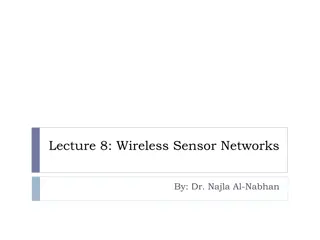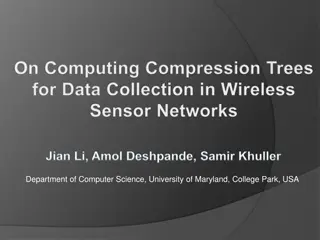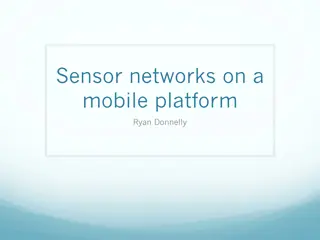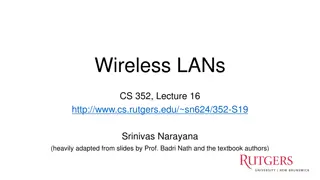Security Protocols & Wireless Sensor Networks
Dive into the realm of security protocols and wireless sensor networks with a focus on achieving a secure system through integrated security components. Explore the motivation behind securing interconnected devices in a world where billions access the internet regularly. Learn about historical security breaches like the case of Mary Queen of Scots and understand the importance of security goals and mechanisms in safeguarding information integrity and authenticity.
Download Presentation

Please find below an Image/Link to download the presentation.
The content on the website is provided AS IS for your information and personal use only. It may not be sold, licensed, or shared on other websites without obtaining consent from the author.If you encounter any issues during the download, it is possible that the publisher has removed the file from their server.
You are allowed to download the files provided on this website for personal or commercial use, subject to the condition that they are used lawfully. All files are the property of their respective owners.
The content on the website is provided AS IS for your information and personal use only. It may not be sold, licensed, or shared on other websites without obtaining consent from the author.
E N D
Presentation Transcript
Security: Protocols, Wireless Sensor Networks & Phishing Rakesh Verma Computer Science Department University of Houston Houston, TX
Motivation Explosion of Devices and Interconnectivity How big is the Internet? An estimated 2.2 billion people access the net regularly from a computer, smart phone, tablet, TV, or other device. [health- information-technology.net/internet-size/ The Indexed Web contains over 3.76 Billion Pages [Worldwidewebsize.com] Mobile devices, tablets and computers are proliferating Internet of things is coming next
To achieve a secure system, security must be integrated into every component, since components designed without security can become a point of attack. [Perrig, Stankovic, Johnson 2004] From Day One! and he is skillful in defense whose opponent does not know what to attack. [Sun Tzu, The Art of War]
How did Mary Queen of Scots die? Mary was misled into thinking her letters were secure, while in reality they were deciphered and read by Walsingham. [wikipedia.org/wiki/Mary_Queen_of_Scots] In general, when message M is transmitted from Alice to Bob, we have the following possibilities: 1. M may be read by someone else. 2. M may be modified in many different ways a. Sender information changed b. Insertion, deletion, reordering of content, etc. 3. M may be replaced by M (extreme form of modification) 4. M may be mis-delivered, delayed, lost, etc.
Security Goals Security (CIA4N) Confidentiality who can access the information Integrity message/data tampering Authenticity (includes source and timeliness) Availability denial of service can be costly Accountability who was at fault Access Control/Authorization who is authorized Nonrepudiation Nondeniability Other goals (not addressed here) Privacy who controls the information Reliability can we depend on it
Security Mechanisms C: Symmetric or asymmetric key cryptography I : Message Authentication Code (MAC) or secure hash functions Authent. : Challenge-response protocol, digital signatures Avail. : Captchas, games, statistical analysis Account. : Audit trails, logs, etc. Access : Role-based access control Nonrep. : specialized protocols with or without trusted third party (expensive)
Outline Cryptography Basics Cryptographic Protocols Typical Challenge Response Protocol Freshness Verification Wireless Sensor Networks Special characteristics and attacks Key Distribution: R-LEAP+ Phishing Email Detection: Phishnet-NLP Conclusions and Future Directions
Cryptography Basics Encryption, E, and Decryption, D, Algorithms are published The secrecy of the encrypted message is based on a key Example: In the Caesar Cipher the key is the shift value Mary Nbsz is a shift of one Secret Key or Symmetric Key Cryptography: just one key for both encryption and decryption Example: Encryption: M ex-or K = M and Decryption: M ex- or K = M since K ex-or K = 0 Public (or Asymmetric Key) Cryptography: two keys K and K : K is public and K private such that E and D are inverses of each other E(K: M) = M and D(K : M ) = M also E(K : M) = N and D(K: N) = M
Cryptographic Protocols Are everywhere in networks: HTTPS, SSL/TLS, etc. Can have subtle flaws even if the cryptographic algorithms are secure
Protocol Example Challenge-response Protocol for Mutual Authentication Goal: Over an open communication channel, Alice and Bob want to ensure that they are talking to each other only Assumption: Attacker Mallory is listening in. Knows public key of all honest principals Learn from messages Construct new messages and then inject them Assumption: Alice and Bob have generated and obtained each other s public keys Ka and Kb. Only Alice has the decryption key for Ka and only Bob has the decryption key for Kb. Assumption: Cryptographic algorithms are secure. Without the secret key, message cannot be deciphered
Challenge-response Protocol Message Alice Bob E(Kb: Na, A) Alice s challenge Bob Alice E(Ka: Na, Nb) Bob s response and challenge Alice Bob E(Kb: Nb) Alice s response Notation: E(K: M) Message M encrypted with Key K Na random number generated by Alice Nb random number generated by Bob [Needham-Schroeder, Communications of the ACM, 1977]
Man In The Middle Attack Alice Mallory Mallory(Alice) Bob Bob Mallory(Alice) Mallory Alice Alice Mallory Mallory(Alice) Bob E(Km: Na, A) E(Kb: Na, A) E(Ka: Na, Nb) E(Ka: Na, Nb) E(Km: Nb) E(Kb: Nb) Session 1 Session 2 Session 2 Session 1 Session 1 Session 2 If Mallory can convince Alice to communicate with him, then Mallory can convince Bob that he is communicating with Alice [Gavin Lowe, Information Processing Letters, 1995]
How to Fix it? Alice Bob E(Kb: Na, A) Bob Alice E(Ka: Na, Nb, B) Alice Bob E(Kb: Nb)
Freshness Bob and Alice meet at a conference in Dehradun Bob leaves a note at the conference desk for Alice on the last day of the conference for a meeting at a cafe 20 Years Later Bob and Alice meet at another conference in Dehradun Alice finds a note at the conference desk for a meeting at the same caf Alice arrives but Bob does not What happened? Bob s note: Hi Alice, Meet me at the Green House Caf today! - Bob
Freshness In [Liang-Verma 2008]: Precise definition of freshness and attacks A series of algorithms and complexity results for checking freshness goals in different scenarios Different attackers with different capabilities and knowledge Different bounds on the number of role instances
Protocol Verification Exciting and important subfield of security Most security goals are undecidable in general Still, many results and protocol verifiers such as AVISPA, ProVerif, etc. More work is needed for protocols involving timing information and richer set of security goals
Wireless Sensor Networks (WSNs) Small, inexpensive sensors are now available for many tasks Networks containing sensors in the thousands are feasible Use the radio channel [coe.berkeley.edu] Sensors are computationally limited. Memory size is small, typically 4K Bytes Numerous applications: monitoring pollution, buildings, healthcare, warfare, etc. Remember: Wireless does not necessarily imply mobile!
Special Characteristics and Attacks Sensors are deployed in unsafe or hazardous environments Limited in energy, computation and communication abilities Many security mechanisms such as public key cryptography are not feasible for WSNs Limited also in communication range due to battery Besides the usual security goals of confidentiality, authentication, etc., some special attacks for WSNs are: Denial of Service attacks are much easier (Availability) Sensor nodes can be captured or compromised (Physical security) Resource depletion attacks (Availability)
Key Management for WSNs Once a WSN is deployed, how are cryptographic keys set up between neighboring sensors Neighboring sensors: sensors within communication range of each other Also known as: Key Establishment or Key Distribution Problem
Key Management Protocols Localized Encryption & Authentication Protocol/LEAP+ [Zhu et al. 2003, 2006] Use cryptographic hash functions Time limit on key establishment phase (prone to jamming attack) Key predistribution [Eschenauer, Gligor 2002] LEAP++ Include preauthentication [Lim 2008] R-Leap+ [Blackshear, Verma 2010] No time limit Combines positives of LEAP+ and Key Predistribution
Phishing? The fraudulent practice of sending e-mails masquerading as a trustworthy entity in order to induce individuals to reveal personal information
Phishing? The fraudulent practice of sending e-mails masquerading as a trustworthy entity in order to induce individuals to reveal personal information Information that phishers are generally looking for: username, password, credit card details from Online payment service account, e.g. eBay, amazon, paypal bank accounts
Phishing? The fraudulent practice of sending e-mails masquerading as a trustworthy entity in order to induce individuals to reveal personal information Information that phishers are generally looking for: username, password, credit card details from Online payment service account, e.g. eBay, amazon, paypal bank accounts
Motivation o July 2011 Aug 2012: 115 Phishing msgs passed through my spam filter. ~ 9/month. Internet users are frequently targeted for theft of sensitive information Email is a popular medium for such attacks Problems include: lost time, lost productivity & monetary loss Date: Tue, 13 Sep 2011 09:09:52 -0600 From: XYZ <abc@sw1.k12.wy.us> To: undisclosed-recipients: ; Subject: Mail Box Quota Exceeded Your web mail quota has exceeded the set quota which is 3GB. you are currently running on 3.9 GB. To re-activate and increase your web mail quota please click the link below. <CLICK HERE> Failure to do so may result in the cancellation of your web mail account. Thanks, and sorry for the inconvenience Local-host.
Motivation It is non-trivial to distinguish phishing messages from legitimate messages, since phishing messages are constructed to resemble legitimate messages as much as possible. [Irani, Webb, Giffin, Pu 2008]
Example Phishing Activity Trends PhishNet-NLP Text Analysis Header Analysis Link Analysis Results Related Work Conclusion & Future Work Example Phishing Email
Example Phishing Activity Trends PhishNet-NLP Text Analysis Header Analysis Link Analysis Results Related Work Conclusion & Future Work Example Phishing Email Fraudulent Link
Example Phishing Activity Trends PhishNet-NLP Text Analysis Header Analysis Link Analysis Results Related Work Conclusion & Future Work Example Phishing Email Fraudulent Link
Example Phishing Activity Trends PhishNet-NLP Text Analysis Header Analysis Link Analysis Results Related Work Conclusion & Future Work H1 2011 data obtained from Anti Phishing Working Group (APWG)
Example Phishing Activity Trends PhishNet-NLP Text Analysis Header Analysis Link Analysis Results Related Work Conclusion & Future Work H1 2011 data obtained from Anti Phishing Working Group (APWG) Estimated losses = $520 M Assessed by EMC Corporation
Example Phishing Activity Trends PhishNet-NLP Text Analysis Header Analysis Link Analysis Results Related Work Conclusion & Future Work PhishNet-NLP Our Implementation Three boolean classifiers: Text Analysis Header Analysis Link Analysis Combines results from each classifier to decide if email is phishing Analyzes emails before reaching mailbox to prevent attack by spywares and trojans Use contextual information of links for efficiency No training on or annotation of emails Dataset 4550 phishing emails (available online) 1000 legitimate emails (from authors mailbox)
Example Phishing Activity Trends PhishNet-NLP Text Analysis Header Analysis Link Analysis Results Related Work Conclusion & Future Work PhishNet- NLP Flowchart
Example Phishing Activity Trends PhishNet-NLP Text Analysis Header Analysis Link Analysis Results Related Work Conclusion & Future Work Extracts text from email Text Analysis Uses NLP Techniques 1. Named-entity extraction (person, place, organization, date, money) 2. 3. Part-of-speech tagging Word-sense disambiguation for polysemous verbs (Example: John gets it, The child got scared, Bob got a speeding ticket) 4. 5. Stemming WordNet (needs part-of-speech, stem and sense) Scores certain verbs, takes maximum score and compares with threshold (set to 1) Score increased with link, urgency, or incentive in same sentence
Example Phishing Activity Trends PhishNet-NLP Text Analysis Header Analysis Link Analysis Results Related Work Conclusion & Future Work Semantics Uses hyponymy relation on verbs (Example: verb click is a hyponym of verb move) Uses context (user s sent/recd. mail) when available Increases robustness provided phisher does not have access to context Increases detection Email scored for similarity and assigned a context-score Text score and Context-score combined logically Text Analysis
Example Phishing Activity Trends PhishNet-NLP Text Analysis Header Analysis Link Analysis Results Related Work Conclusion & Future Work Context Score Details: Email converted to vector using Information Retrieval techniques TF-IDF: Term Frequency-Inverse Document Frequency TF No. of occurrences of a word within a document IDF measure of how infrequently the word appears in other documents in the database Text Analysis Similarity score: Cosine of the angle between vectors Thresholding
Example Phishing Activity Trends PhishNet-NLP Text Analysis Header Analysis Link Analysis Results Related Work Conclusion & Future Work Text Analysis Scored Verbs
Results Related Work Conclusion & Future Work Example Phishing Activity Trends PhishNet-NLP Header Analysis Link Analysis Results Header Analysis Classifier - DKIM - SPF
Text Analysis Header Analysis Link Analysis Results Results Related Work Conclusion & Future Work Extract Email Header Extract Signing Domain Identifier (SDID) if header contains a DKIM signature Otherwise extract first Received from field
Example Phishing Activity Trends PhishNet-NLP Text Analysis Header Analysis Link Analysis Results Related Work Conclusion & Future Work Extract Email Header Extract Signing Domain Identifier (SDID) if header contains a DKIM signature Otherwise extract first Received from field Check if the field extracted above is same as the From Field If same, then legitimate Otherwise, also legitimate if any forwarding email address is same as From Field
Example Phishing Activity Trends PhishNet-NLP Text Analysis Header Analysis Link Analysis Results Related Work Conclusion & Future Work Significance of DKIM (Domain Keys Identified Mail www.dkim.org) Method for validating a domain name identity through cryptographic authentication E.g. Gmail The following email is legitimate:
Example Phishing Activity Trends PhishNet-NLP Text Analysis Header Analysis Link Analysis Results Related Work Conclusion & Future Work Significance of DKIM (Domain Keys Identified Mail www.dkim.org) Method for validating a domain name identity through cryptographic authentication E.g. Gmail The following email is legitimate:
Example Phishing Activity Trends PhishNet-NLP Text Analysis Header Analysis Link Analysis Results Related Work Conclusion & Future Work SPF (Sender Policy Framework www.openspf.org) Email validation system that verifies sender IP address PhishNet-NLP s use of SPF If header contains SPF query that returns pass , then if domain in From Field designates sender s IP address as permitted sender then legitimate
Example Phishing Activity Trends PhishNet-NLP Text Analysis Header Analysis Link Analysis Results Related Work Conclusion & Future Work SPF (Sender Policy Framework www.openspf.org) Email validation system that verifies sender IP address PhishNet-NLP s use of SPF If header contains SPF query that returns pass , then if domain in From Field designates sender s IP address as permitted sender then legitimate
Example Phishing Activity Trends PhishNet-NLP Text Analysis Header Analysis Link Analysis Results Related Work Conclusion & Future Work Email is phishing if all of the above fails
Example Phishing Activity Trends PhishNet-NLP Text Analysis Header Analysis Link Analysis Results Related Work Conclusion & Future Work Link Analysis Classifier Extract all links Email legitimate if no links present Else if any link is found in a phishing database (phishTank), then phishing Else Google Search each domain + top 4 TF-IDF terms in the email if all domains appear in the top 30 search results, then legitimate Otherwise, phishing Bing as backup in case Google search yields a DoS Keep context of legitimate and phishing links to speed up future searches NOTE: not clicking on the links, which prevents entry of trojans, malwares
Example Phishing Activity Trends PhishNet-NLP Text Analysis Header Analysis Link Analysis Results Related Work Conclusion & Future Work Results
Example Phishing Activity Trends PhishNet-NLP Text Analysis Header Analysis Link Analysis Results Related Work Conclusion & Future Work PhishCatch(Yu et al., 2009) heuristic algorithm performs mainly header and link of emails uses 3710 phishing emails from same corpus as us, and 1094 legitimate emails obtains a phishing detection rate of 80% and an accuracy of 99% CANTINA (Xiang et al., 2011) detects phishing websites based on information retrieval and text mining algorithms web sites must be visited by CANTINA, may install malwares uses 100 phishing and 100 legitimate sites detects 89% phishing sites, with an accuracy of 99% PILFER (Fette et al., 2007) machine Learning (Logistic Regression) uses 10 Features, mainly extracted from links and email content type uses 860 phishing emails and 6950 legitimate emails detection = 92%, accuracy = 99.9%
Example Phishing Activity Trends PhishNet-NLP Text Analysis Header Analysis Link Analysis Results Related Work Conclusion & Future Work Algorithm Phishing Detection Accuracy PhishCatch 80% 99% CANTINA* 89% 99% PILFER 92% 99.9% *only detects phishing websites
